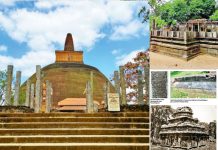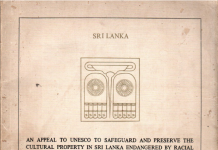“I believe that it is better to tell the truth than a lie. I believe it is better to be free than to be a slave. And I believe it is better to know than to be ignorant.”
—H. L. Mencken
UNESCO says, “Three-quarters of the world’s major conflicts have a cultural dimension. Therefore, bridging the gap between cultures is urgent and necessary for peace, stability, and development.”
We need to know the historical truth in order to understand the present and pave the path to the future. In the absence of the truth, misinformation and misunderstandings grow, leading to dangerous myths and assumptions.
In Sri Lanka, the absence of the truth, and the negligence of the truth has caused the development of myths and prejudices about the island’s history. Among such myths and fables is the myth about a Tamil homeland or a historical Eelam that existed on the island of Sri Lanka during historical times. This belief was the very reason behind the three-decade bloody war and still existing separationist ideologies that disturb the peace and development of Sri Lanka.
Knowing accurate historical facts helps us understand what happened in the past and to eventually dissolve such myths and fables about Sri Lanka’s history. Apart from the Eelam Tamil homeland myth, the Ravana myth, Buddha-was-born-in Sri-Lanka myth, Catholicism flourished as a cult in Sri Lanka during the Anuradhapura Period, aliens created ancient civilisations on earth, civilisation spread to almost all parts of the world from a large continent of the ancient Hela people, and so on, are to name a few more myths that are severely threatening and damaging the country as a whole. These myths should be decoded and should be proven as mere fables, and should be shamed and dissolved.
Ceylon Today have in-detail explored the Ravana myth and the Buddha-was-born-in-Sri-Lanka myth in our previous segments. In our latest series of articles, we shall explore the Tamil homeland myth and embark on a journey to examine the history of the Tamil people in Sri Lanka. In a series of previous articles, we explored the archaeology and the historical period of the Northern and Eastern provinces of Sri Lanka in more than over 20 articles.
History is based on facts, not fables
We study and recreate the past based on data. Data or evidence we use to recreate history should be solid and cannot be misinterpreted. They tell a story that is true and unchangeable. History recreated on such evidence is accurate. Therefore, we present to you evidence from the past. We present ancient inscriptions, coins, art and architecture, and chronicles. Based on those facts, we shall explore the history of the Tamil people in Sri Lanka.
The history of Tamil people in Sri Lanka
Sinhale: A land where many ethnic and religious groups lived in harmony
Those who created the civilisation of this little island are known as the Sinhala race. The greatest city built by the Sinhala race is Anuradhapura. Hence, the civilisation centred on Anuradhapura was known as the Rajarata Civilisation. Rajarata means the ‘Land of the Kings’.
However, this does not mean that no other ethnic groups existed on this island along with the Sinhala race. A group of people known as Dravida or Damida lived during the Anuradhapura Period. This is what inscriptions reveal.
Before we go into detail to learn about what inscriptions say, we shall pay attention to something interesting recorded in the Mahavamsa or the Great Chronicle.
In the 10th chapter of the Mahavamsa, it says that King Pandukabhya who created the Anuradhapura for the City of Anuradha allocated separate places for different religious groups and groups of people to live in the city. Through this, we can understand that various minorities lived in Sri Lanka and the king had patronised them. We do not have any records of an ethnic or religious conflict that happened during historical times in Sri Lanka.
Also, we understand that ideas such as discrimination against minorities and natives and marginalising minorities are all practices and concepts that were planted here by the western invaders. Prior to the 16th century, in Sri Lanka, we see struggles between dynasties and royal lineages such as the Mauryans, Lambakarnas, Pandyas, Pallavas, Gangas, Cholas, Chalukyas, Kalingas, and so on, but not battles and struggles between ethnicities.
The chronicles were written in Pali and Sinhala languages and other Pali, Sinhalese, and Sanskrit historical texts also, record the history without being biased. In our last week’s article, we said that according to the Mahavamsa King Chandramukhasiva had a Damila Devi or a Damila Queen. If the Mahavamsa author was a racist, or if there had been an ethnic conflict between the Sinhala and Tamils when the Mahavamsa was written, he wouldn’t have said that the king had a Tamil queen. The Mahavamsa further says that she did offerings to a Buddhist temple.
The best example of the non-bias and non-racist point of view of our ancient chronicles is how fairly they have reported about the usurpers and invaders including the many from South India. Elara who ruled Anuradhapura for 44 years is portrayed as a fair king. Even the Cholas are not hated by the chronicle writers. This is a quality a trained scholar must have.
Inscription of a Tamil householder and Tamil Buddhist monks, at Anuradhapura
This inscription is known as the Anuradhapura Tamil Householder’s Terrace Inscription by Prof. Senerath Paranavithana. Prof. Paranavitana explains that this inscription reveals that there had been a council hall of a Dravida company during this time which is prior to the Christian era at Anuradhapura. This inscription was discovered by Prof. Paranavitana in the year 1939.
Further explaining, Prof. Paranavitana writes that the inscription revealed novel information about a monument that has not been found before even in India. This unique monument is a construction of a building that is identified by him as a council hall that has been created by shaping the natural rock of the place, levelling it, creating seats, and then fixing a roof to the building. There are six seats at the place that is cut in the shape of a stairway. The inscription is carved above the row of seats.
It reads as follows;
Ilubatharehi Dameda Shamane Karithe Dameda Gahapathikana Pashade
This has been translated into,
“The Dravida Householders’ Prasada was created by Dravida Shamane (Buddhist monk) of Ilubathara.”
Six more inscriptions are engraved below each seat, giving the names of those who were assigned to each seat.
They are as follows;
Shagasaha ashane (Saga’s seat)
Nashathasah ashane (Nasathasa’s seat)
K…. Thisaha ashane (….. Thissa’s seat)
….. Ashane (….. seat)
Kubira Sujathaha ashane (Kubira Sujatha’s seat)
Navaka Karawaha ashane (Naval officer Karaavaha’s seat)
Reading these inscriptions
Prof. Paranavithana believes that this is a council hall of a Dravida company or guild and that this building was of the common use of Dravida householders (Gruahpathin).
He has dated the inscription somewhere between the 3rd to 1st century BCE based on the script of the inscription. He further states that during this time period, during 177 – 155 BC, 145 – 101 BC, and 33 – 77 CE Rajarata was invaded thrice by Dravidians and was briefly ruled during these
above-mentioned time periods. Hence,
Prof. Paranavithana assumes that the construction of this pasada must have happened during one of these time periods. He further explains that to build a pasada for a Dravida company and for the existence of a Dravdia company in the country, there need not necessarily have a Dravida rule in the country and therefore, this also could be a construction and a company that existed during the time of a Sinhala ruler.
Although the interpretation of
Prof. Paranavithana about the pasada or a council hall has been argued and discussed further and interpreted differently by later scholars, the meaning of the inscription (Ilubatharehi Dameda Shamane Karithe Dameda Gahapathikana Pashade) remains the same. This inscription belongs to the time period from the 3rd to the 1st century BCE. Therefore, this clearly reveals that during the early Anuradhapura Period, Dravida Buddhist monks existed, and Dravida householders and monks together built monuments inside the capital city. They have lived in harmony.
Tamil inscription from Abhayagiriya, Anuradhapura
Prof. Sivasubramaniam Pathmanathan, former Professor of History at the University of Peradeniya, and former Vice Chancellor of the Univerity of Jaffna is a highly acclaimed Sri Lankan historian and academic. For our articles, we interviewed the professor and will be presenting his views on this subject in our upcoming segments.
Here we shall quote from his scholarly work, Tamil Inscriptions in
Sri Lanka, volume I. This is about an inscription written in Tamil, found at Abhyagiriya, Anuradhapura.
“The fragment of a stone-slab with Tamil letters inscribed on it is found on the platform of the Abhayagiriya. It was noticed by S. Bandaranaike, the Publicity Officer of the Abhayagiriya Project of the Cultural Triangle. When the team of Japanese, Indian, and Sri Lankan scholars working on a project relating to the Medieval Maritime Commerce in the Indian Ocean visited the Abhyagiri site on 6 August 1998, they were informed about this particular stone-slab.
“This inscription could be assigned to the 8th century as the letters represent a stage of development characteristics of Tamil epigraphy of the late Pallava Period in South India. There are references to a pali, karapatai, tarai and potiyil in this inscription. All these are lexical items and the text presupposes an interconnection among all of them. The word pali is doubtless a variant of pali which has the connotation ‘cave’ or ‘abode’ of monks. It may therefore be assumed that the inscription concerned refers to the Abhyagiri monastery, which was the principal abode of a section of the monks who had seceded from the Mahavihara.”
Explaining the word potiyil, Prof. Pathmanathan says, “The more plausible explanation is that the expression potiyil is a combination of two words; poti and il. Therefore, potiyil could be considered as the Tamil equivalent of bodhighara, the ‘bodhi shrine’.”
“Facts do not cease to exist because they are ignored.”
—Aldous Huxley,
Complete Essays, Vol. II: 1926-1929
To be continued…
(Information courtesy; Mahavamsa, Purana Abhayagiri Viharaya by Professor T.G. Kulatunga, and Tamil Inscriptions in
Sri Lanka, Volume I by Professor S. Pathmanathan)
By Ama H. Vanniarachchy
Heritage: Ambassadors of peace (Part II)





